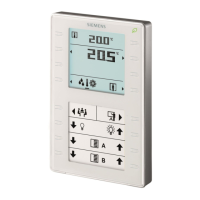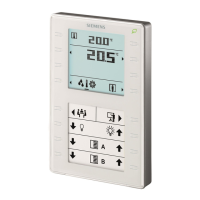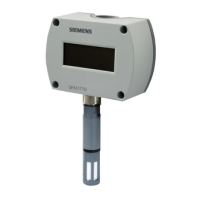22 / 46
Siemens Wall-mounted sensors and room operator units for KNX/ETS and KNX/ACS CM2N1602en_05
Building Technologies Functionality / Use 2018-09-14
days and corrects for any drift detected. The sensor also contains self-
diagnostics to assure proper operation during lifetime.
• U
se: Normal environments, such as offices, class rooms, hotel rooms, or other
non-permanently occupied areas, typically reach at least once a week the CO
2
c
oncentration of fresh air of 400 ppm. However, exposure to a lowest CO
2
concentration other than fresh air, or incorrect altitude parameter setting, might
result in reduced accuracy and incorrect operation.
• Rough handling during transport, storage or mounting might adversely affect
accuracy during the first days of operation.
• The specified accuracy is reached after 25 days of continuous operation.
8 but
tons (individual or button pairs) and related LEDs can be parameterized
individually. See Section 3 for button labels.
Common functions such as switching (On, Off, toggle) or sending of values
(percentage), dimming, or blinds control, 8-bit scene control with/without memorize
are supported.
4.5 Application examples
Below are a few typical application examples for the QMX3.P30, P34, P70 and P74
room operator units.
4.5.1 Room temperature control and operation via QMX3
Key (Possible combination of components)
1. Room operator unit QMX3.P34
2. Presence detector UP 258
3. Motoric valve actuator AP 562/02
4. Window contact S 290
T
his application is recommended for smaller offices with a single heater.
The room operator unit measures and regulates room temperature and sends the
regulation signal to the valve drive actuator via KNX bus.
In addition, window contacts and presence detectors influence the control behavior
of the room operator unit and increase the room‘s energy efficiency. For example, if
Operation of light,
shading and scenes

